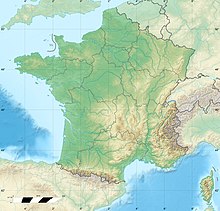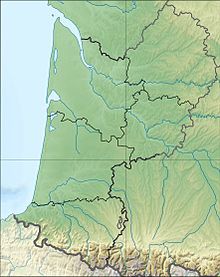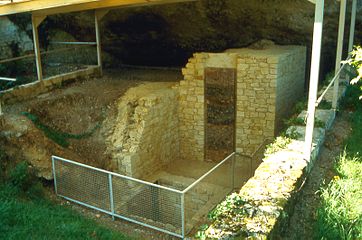Le Moustier
Le Moustier | |
WWII bombing. | |
| Location | Peyzac-le-Moustier |
|---|---|
| Region | Dordogne, France |
| Coordinates | 44°59′38″N 1°3′36″E / 44.99389°N 1.06000°E |
| Site notes | |
| Excavation dates | 1863 |
| Archaeologists | Henry Christy, Édouard Lartet. |
| Part of | Prehistoric Sites and Decorated Caves of the Vézère Valley |
| Criteria | Cultural: (i), (iii) |
| Reference | 85-014 |
| Inscription | 1979 (3rd Session) |
| Area | 0.227 ha (24,400 sq ft) |
Le Moustier is an
World Heritage List along with other nearby archeological sites as part of the Prehistoric Sites and Decorated Caves of the Vézère Valley.[1]
Skeleton
The skeleton known as "Le Moustier" is estimated to be approximately 45,000 years old.[2] The characteristics of its skull include a large nasal cavity and a somewhat less developed brow ridge and occipital bun, as might be expected in a juvenile.
After discovery, the skull was dismantled, cast and reconstructed at least four times. During this process, the skull received considerable amounts of damage; for example, after it was sold to the
German Democratic Republic in 1958.[3] The skull is now missing many parts, the teeth glued into the wrong position, and it has been dipped into glue, covered with varnish, and painted with plaster. Consequently, its scientific value is much reduced.[4]
-
Upper shelter
-
Lower shelter
-
Flint handaxe, excavated 1863, British Museum
-
A box of side scrapers excavated by Lartet and Christy
-
Le Moustier 1 skull today in Neues Museum Berlin.
-
Le Moustier 1 Neanderthal facial reconstitution, Neues Museum Berlin[5]
-
Restoration of Neanderthal Flintworkers, Le Moustier Cavern, Dordogne, France by Charles R. Knight
Stone tools

Study of the artifacts found in Le Moustier reveals the use of
ocher and bitumen by Middle Paleolithic humans to make hand grips for cutting and scraping stone tools.[6]
Experiments by archaeologists showed that the mass was sufficiently sticky so that a small stone tool could get stuck in it and the mass could serve as a handle, but the hands remained clean. This presupposes knowledge of both material characteristics and that a combination of these substances results in a new material. In addition, both components, bitumen and ochre, had to be gathered from different deposits far away from each other. This required planning and foresight in order to optimise the flint blades accordingly.
See also
- List of fossil sites (with link directory)
- List of hominina (hominid) fossils(with images)
References
- ^ "Prehistoric Sites and Decorated Caves of the Vézère Valley". UNESCO World Heritage Centre. United Nations Educational, Scientific, and Cultural Organization. Retrieved 9 October 2021.
- ^ Australian Museum [Retrieved 2012-01-06]
- ISBN 9789814464925.
- ISBN 978-3-211-48647-4.
- ^ Bekker, Henk (23 October 2017). "Neues Museum in Berlin 1175".
- PMC 10881035.)
{{cite journal}}: CS1 maint: multiple names: authors list (link
External links
 Media related to Le Moustier at Wikimedia Commons
Media related to Le Moustier at Wikimedia Commons









![Le Moustier 1 Neanderthal facial reconstitution, Neues Museum Berlin[5]](http://upload.wikimedia.org/wikipedia/commons/thumb/3/38/Le_Moustier_skull_in_Berlin_reconstitution.jpg/207px-Le_Moustier_skull_in_Berlin_reconstitution.jpg)
